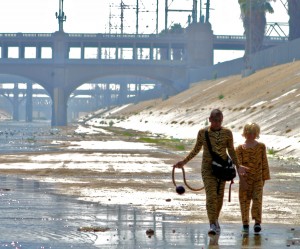Documentary explains pivotal man and mantra
The writings of American mythologist Joseph Campbell left an undeniable imprint on our culture.
Campbell’s famous philosophy can be summed up in three simple-yet-loaded words: “Follow your bliss.”
Finding Joe explores this deceivingly simple mantra with respect to the modern human experience.

Archetypal heroes · Patrick Takaya Solomon’s film Finding Joe dives into the mythical histories of worldwide cultures and features scenes of child actors re-enacting Joseph Campbell’s original stories interspersed with interviews with an eclectic group of intriguing professionals. - Photo courtesy of Pat and Pat Inc.
With portrayals of classic mythologies interwoven with personal anecdotes and insights from a wide range of contemporary figures, the film attempts to inspire a new way of life.
At the risk of becoming a film version of a Campbell self-help book, director and producer Patrick Takaya Solomon takes viewers on an 80-minute ride through “The Hero’s Journey.” The film explores overarching themes from mythologies all over the world.
Not only is this theme found among ancient tales, but the concept of “The Hero’s Journey” is prevalent among contemporary literature and films such as The Wizard of Oz, Harry Potter, The Matrix and Star Wars.
One of the film’s few flaws is the way the message is presented: trite and overdone. Though Solomon intentionally chooses interview subjects from diverse backgrounds — including actress Rashida Jones, celebrity Dr. Deepak Chopra, pro skater Tony Hawk and Twilight director Catherine Hardwicke — the commentary often feels redundant.
Rather than its celebrity lineup, though, Finding Joe finds its strength in compelling visualizations that interpret ancient mythologies with a contemporary touch. The enactments, performed by a motley group of kids who are surprisingly talented actors, effectively keep the stories fresh.
The film begins with a tale of a golden statue of Buddha, which is covered up with armor and concrete to fend off wartime enemies; over time, its true material is forgotten by all.
Author Alan Cohen explains the moral of the story, as it relates to viewers’ lives: We are originally born of purity, but years of conditioning from outer influences pile debris on our unadulterated matter.
“We are not separate from the characters we see in our movies and novels,” Cohen said in the film. “They are us. It’s one journey.”
Pairs of enactments and analysis pace the remainder of the film, keeping the material engaging and fresh without retreating too far from real-life applications. Though the messages behind the ancient tales are often easy to guess, the afterthoughts offered by the interviewees reinforce and supplement viewers’ ultimate revelations.
The film takes a closer look at the three major stages of “The Hero’s Journey”: separation from one’s natural environment, initiation via challenges and tests and finally the triumphant return home to tell the story of archetypal metamorphosis.
The most compelling parts of Finding Joe show several interviewees dropping their inhibitions and sharing deeply personal anecdotes from their own experiences in persevering through these stages. One story is that of Gay Hendricks, who recounts his transformation from a 320-pound, chain-smoking man who hated his job to a trim, best-selling author.
Their accounts illustrate the mythology of “The Hero’s Journey” as not only a plotline of ancient myths, blockbuster movies and bestselling novels but a guide for our quest to find deeper potential within ourselves.
By taking a seemingly clichéd mantra such as “Follow your bliss” and pairing it with true, relatable accounts from contemporary figures, the film invites viewers to dig deeper into their own psyches.
Though Finding Joe is unlikely to throw one’s world upside down, it does offer plenty of food for thought, pressing the need for what might be a well-deserved self-examination.
